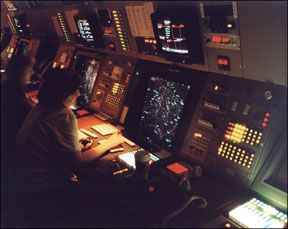For some flights, filing and flying in the IFR system is the way to go. For others, its appropriate to turn off the radios and revel in being one with the machine, without external distractions. Somewhere between these two extremes exists VFR flight following, a neither-fish-nor-fowl compromise of obtaining ATC services on a workload-permitting basis but without as many rules. For many cross-country 288 flights, its the right solution to the question, “Shouldnt you be talking to somebody?” Like so many other things in aviation, theres a right way and a wrong way to go about it. For example, using the mouth to ask for flight following before engaging the brain to efficiently make the request can guarantee a terse “unable.” And once you get your magic squawk code and radar contact is advised, you can relax-a little-satisfied ATC will keep most of the big stuff away from you. But flight following isnt a final solution to your navigation or see-and-avoid procedures. What It Is Whether you call it VFR advisories or-as the FAA labels it in the Aeronautical Information Manual, the AIM-radar traffic information service, flight following is provided by ATC to advise VFR flights of observed radar targets warranting their attention. It differs from separation services in Class B and C airspace, as well as sequencing in Class D, and is primarily used in the en route environment. Because its voluntary for the pilot and discretionary for ATC, both sides of the mic have a role to play. The controllers basic role is to advise the pilot of the aforementioned radar targets and, if the pilot requests, provide suggested headings to avoid it. Meanwhile, the pilot needs to listen up. Anytime were using ATC services is a lousy time to turn down the comm radios volume and tell war stories. Its also a bad time to be chatty, or bombard ATC with questions, since the controller likely has at least one other sector/frequency to monitor. Except late at night, and sometimes not even then, its rare these days to find a controller without lots of traffic. Other things the pilot needs to do is advise the controller of any heading or altitude changes, before they are made. Dont ask permission; nothing confirms your inexperience more than a VFR aircraft in Class E airspace asking for an altitude change. Instead, it should go something like, “Center, be advised SkySmasher 12345 is climbing out of six-thousand five-hundred for eight-thousand five-hundred.” Then wait for acknowledgement before executing the maneuver. Same for a heading, route or destination change-VFR rules apply, and you can go pretty much where you want at what altitude you want. As much as we may want to defer to the controller, its not his or her job to fly our airplane for us. Most of the time, controllers also will provide a range of other services-often without being asked-including assistance with avoiding hazardous weather or terrain. And, of course, any VFR aircraft experiencing an emergency will receive assistance much more quickly if its already “in the system” (see the sidebar at right). What It Isnt Flight following is not intended to relieve a pilot of responsibility for seeing and avoiding other aircraft. Period. That responsibility remains with the pilot in command and, unless on an IFR flight plan and in instrument conditions, always resides in the front left seat. One important thing to remember is flight following is provided by ATC on a workload-permitting basis: If youre droning through RJ-saturated airspace as they queue up to arrive at Regional Hub, its likely the controller will be a tad busy. You wont be told about all nearby traffic, so you still need to look out the window. The service also isnt IFR; pilots receiving it are expected to observe cloud-clearance and visibility rules appropriate for the airspace (usually Class E) and altitude. Thats a double-edged sword, of course, since ATC shouldnt be vectoring you or changing your altitude. In fact, the AIM specifically states: “VFR radar advisory service does not include vectors away from conflicting traffic unless requested by the pilot…. Pilots should also inform the controller when changing VFR cruising altitude.” Tips Some random suggestions for making the most of flight following: Stay on the frequency. Nothing can ruin your day faster than a mid-air with traffic ATC could see but didnt tell you about because you changed frequencies without telling anyone. Dont squawk 1200 unless asked. Changing your transponder code can create all kinds of havoc-dont do it. Nearing the destination, plan your descent as you would without flight following, but advise ATC and get acknowledgement beforehand. If its a Class B/C/D facility, youll keep the same code and be handed off to your destinations tower. When your destination is a non-towered airport, or you depart radar coverage, youll be asked to squawk 1200 and advised, “radar service terminated.” Ask for a strip. Often, the controllers workload allows giving you service, but not much else. One way you might know is receiving a squawk code beginning with “0,” which generally means its a local code, not one entered into the regions center computer. The practical effect of not being in the computer is service will be terminated on leaving the facilitys airspace-no handoff for you. Usually, the controller will do this automagically when your destination is one or more facilities away. But it doesnt hurt to ask-when theres a lull in the conversation-if youre curious. Finally, and as weve written many times, listening to how pilots and controllers interact to solve problems is the best training you can get when it comes to understanding how ATC works.




